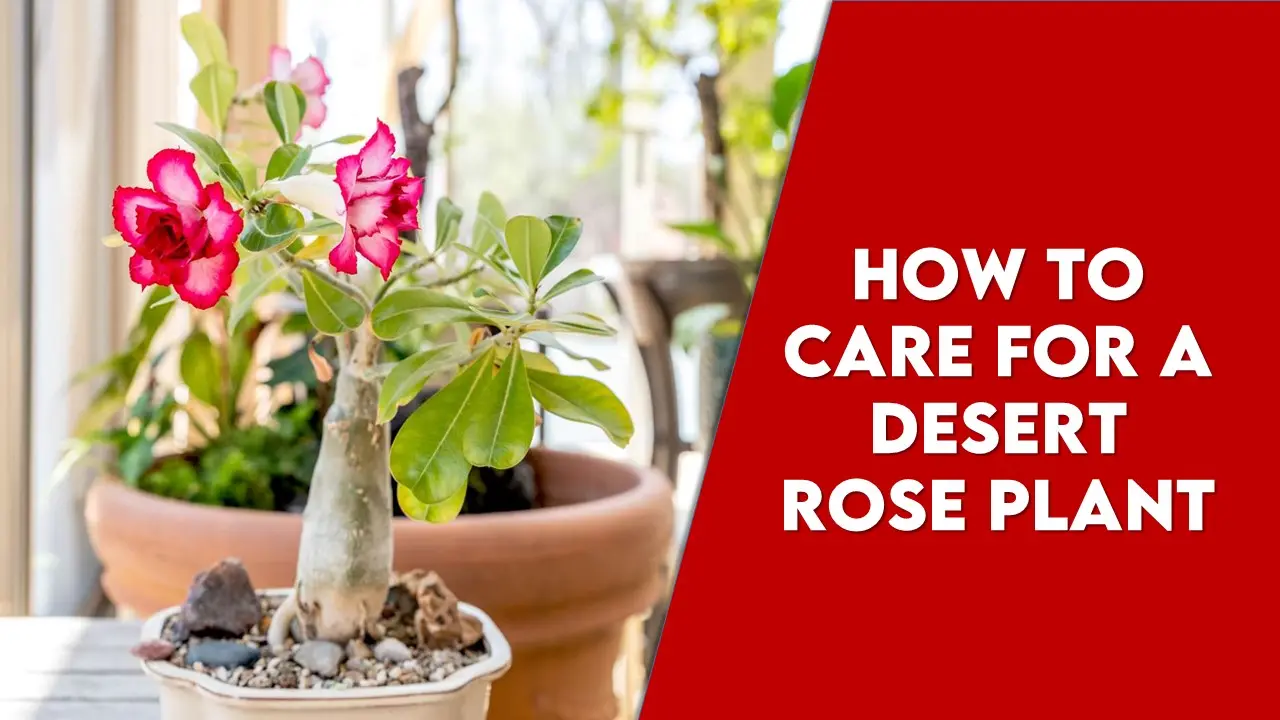How to Care for a Desert Rose Plant: A Complete Guide
With its peculiar morphological characteristics, the Desert Rose Plant is easy to identify and thrives well even in harsh conditions. In this article we will learn about how to care for a Desert Rose Plant to glorify your garden.
Desert Rose is a plant to symbolise fortitude, prosperity, and fortune. In China, it is said that the owner of this plant always prospers with wealth and luck never leaves their side. This plant has a thick succulent trunk, delicate leaves, and deep pink trumpet flowers. Growers take advantage of this feature and sell it as a bonsai tree that costs around ₹1000-2000/mature plant(i.e.–9 ft. tall, 3–5 ft. wide).
Like many other succulents, the Desert Rose Plant grows slowly, only up to twelve inches per year, and requires less maintenance. Hence, it is quite suitable for indoor plant categories.
The only advantage of this plant is its beauty, it is purely ornamental but the latex induced from its sap is poisonous to humans and animals. Hence, should be kept away from the reach of pets, and children. Desert Rose Plant is native to Africa. In warmer or tropical regions it could be grown as an outdoor plant but in temperate or cold areas, it needs special attention from its owner.
How to Care for a Desert Rose Plant: climatic requirements
Even though it requires less maintenance, its climatic requirements, water management and fertiliser needs should not be neglected, as it is said, the more you care, the better the plant survives.
The plant doesn’t always provide profuse flowering, it only blooms red and pink during the late summer and sheds its leaves and flowers in winter, showing a sign of dormancy. After taking a rest during the whole winter, it regains its strength and flowers again the next year. But it only happens when the plant is provided with the following climatic conditions.
Light
It is known to thrive best under full sunlight. For indoor conditions, a place receiving maximum hours of sunlight is best for the plant, like a south-facing window where it could get an ample amount of sunlight. For outdoor conditions, it is best to grow these plants that are not shaded by the other plants but have some protection to prevent heat shocks.
Temperature and Humidity
A temperature between 18°C to 32°C is mostly recommended for this plant. If the surrounding temperature for this plant goes beyond 10°C, the plant will start deteriorating, i.e. the overwintering of the Desert Rose Plant. Therefore Desert Rose Plant should always be kept in a warmer area. This is one of the reasons this plant doesn’t show good results in outdoor conditions.
Any fluctuations in temperature affect the plant in one way or another. As this plant is accommodated in dry and hot climates, humidity doesn’t play an important role in its growth.
Soil
Sandy and well-drained soil with neutral or slightly acidic pH(6-6.5) is necessary to let its roots explore and get nutrition. In waterlogged conditions, its roots rot and ultimately the plant dies. In natural conditions, it grows in dry or desert conditions.
Water
Water requirements of this plant differ as per the temperature, season, and stage of plant life. As the root of this plant is susceptible to rot, a clay or terra cotta pot with a good drainage system is preferred for its growth. In its early stages, the soil should always be moist. However, the intensity of irrigation must be decreased as the plant matures. It should be irrigated only when 3-4 inches of upper soil dry completely. It is advised to water only once a month during the winter season.
The trunk of this plant is like a camel’s hump. It is an indicator that the plant has enough water content. If it is well swollen, it means the plant is well hydrated.
Fertilizer Requirements
Fertiliser application during dormancy(Winter) is useless. Diluted liquid fertiliser is recommended to be applied once a month during an active growth period(Spring to Summer). Phosphorus-rich fertilisers can boost the blooming and an excessive nitrogen application will only lead to vegetative growth and no flowering. A slow-release fertiliser could also be useful. One can also add compost or bone meal for its healthy growth and organic health. Apply the fertilizer once a month during the summer and spring seasons.
Pruning
When asked how to care for a Dessert Rose Plant, always consider careful pruning. Always cut above a node while trimming the stems. One can remove the old and dead stems when a new stem starts emerging. Any intervention stems should also be removed as they will disturb the symmetry of the plant. But one must not forget to sterilize the pruning equipment(rubbing alcohol or a bleach solution can be used), as pruning is still like injuring the plant and leaving open tissues in the environment, it makes the plant susceptible to bacterial growth.
Propagation of Desert Rose Plant
how to grow Desert Rose Plant From Stem Cuttings
Cutting should always be done in summer or spring when growth is minimal.
- Wear gloves as the sap of the plant is toxic, and cut about five to six inches of cutting from the tip of the branch by using a pruning snip.
- Let the cuttings dry for at least two days.Wet the cut end with water and dip it in the rooting hormone like IBA(Indole Butyric Acid) which will allow early and healthy root growth.
- Allow the well-rooted cutting to grow in a well-mixed perlite or gravel mixture in a pot.
- Put the pot in a light shady area and well water the plant as described above.
- Around six weeks the new stem growth will start in the plant, which indicates that the plant is well established now.
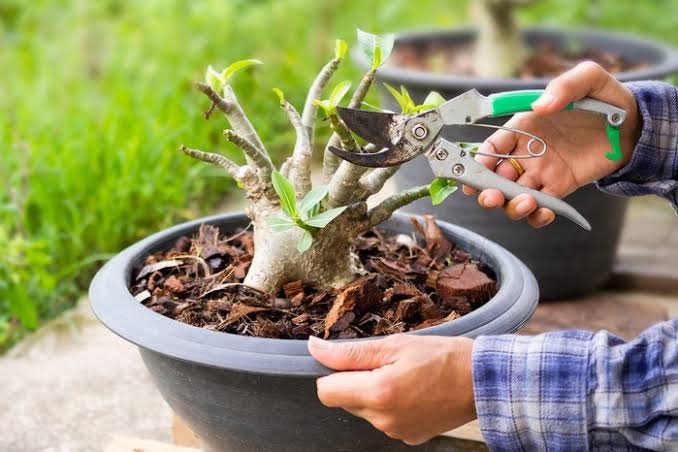
how to grow Desert Rose Plant From Seeds
The best time to sow Desert Rose Plant seeds is in summer or spring.
- Select the seed of your desired variety that is well-treated and certified by responsible authorities.
- Prepare a well-drained mixture of soil in an ideal pot.
- Pre-soak the seed in water for early sprouting and sow it in the soil up to two inches.
- Cover it with a thin layer of soil and water lightly to settle the soil over the seed and place it in a shady area, to avoid undesirable loss of water.
- Irrigate the pot lightly, one can also use a mistifier to provide adequate moisture to the plant.
- The seed will sprout in about a week or ten days. Once it is sprouted, move it to a sunny area for further growth.
One must know that propagating the Desert Rose Plant through Stem cutting will not result in a well-grown trunk but plants grown from seed will always have a beautiful desirable trunk. It will bloom after seven to eight months from sowing time.
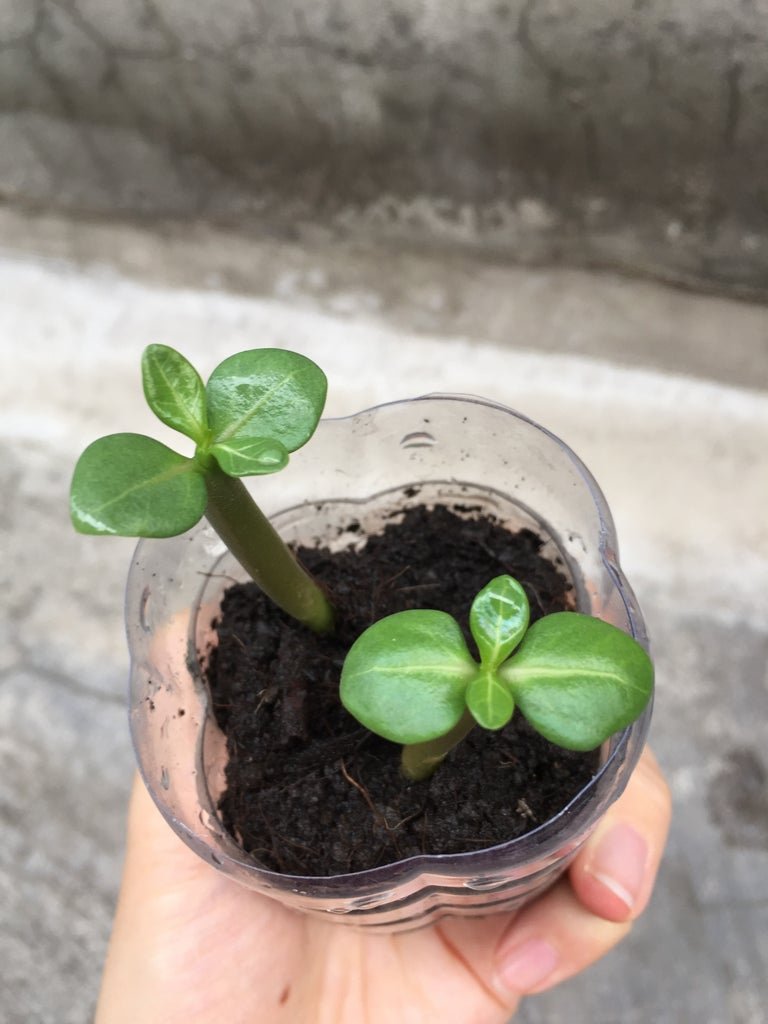
Potting and repotting in desert Rose Plant
Potting is done in case when there is no space for new roots to emerge in the old pot. It usually happens after a year of first potting. If one will not consider repotting then the plant growth will decrease.
Repotting is done in case when the health of the plant deteriorates. In such a case, carefully remove the plant roots from the pot, and check for the rot or infected part of the roots. Cut and remove the affected part. Remove the old soil fill the new soil mixture and apply fungicides like Mancozeb, Chaubatia paste or Bordeaux mixture in the soil to prevent further disease infection.
The best time for repotting is during late summer and early spring. Let the plant dry for a week after repotting to avoid the shocks and then start watering it in adequate quantities.
Types of Desert Rose Plant
Adenium obesum subsp. oleifolium
It is native to South Africa, it grows up to eighteen inches and has a large tuberous stem with olive green leaves, and pink and red tubular flowers.
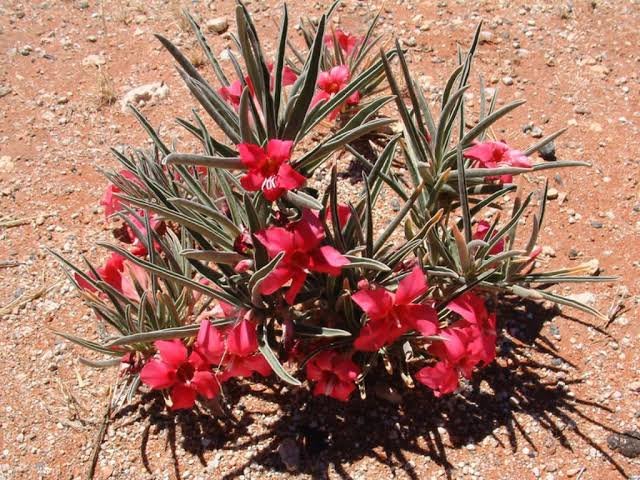
Adenium obesum subsp. socotranum
Native to Socotra, It is the largest species among Desert Rose Plants that grows up to 15 feet with an 8-foot diameter trunk. It flowers in leafless condition.
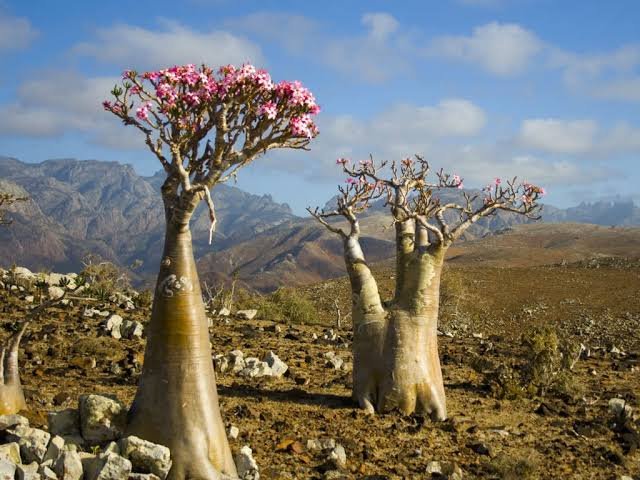
Adenium obesum subsp. somalense
This species of Desert Rose Plant has narrow leaves and twisted branches. It has Trumpet-shaped flowers with pink, white, or crimson red shades.
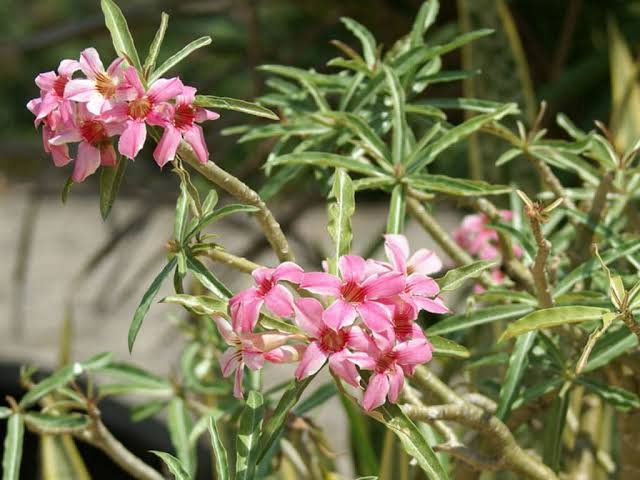
Adenium obesum subsp. swazicum
This species is commonly known as Summer Impala Lily. This is a dwarf species that grows only up to a height of two feet. It has pink to reddish-pink flowers.
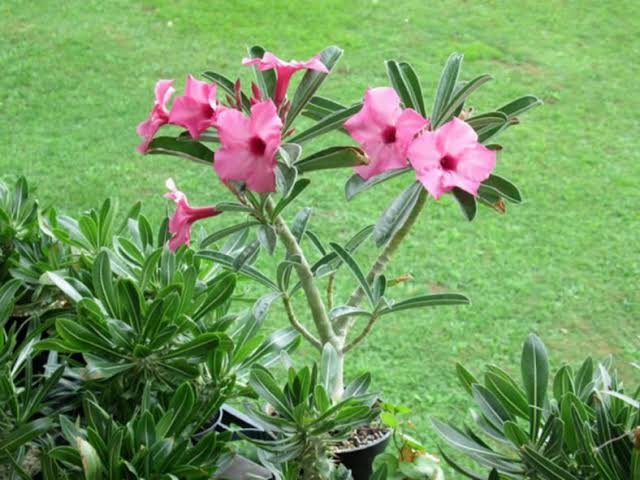
Problems with Desert Rose Plant
Physiological Problem(Yellow leaves or leaf drop)
It occurs due to overwatering in plants, which results in root rot. The cause of this condition is many soil-borne fungi. If the condition is detected early the plant could be saved by the process of repotting and fungicide application.
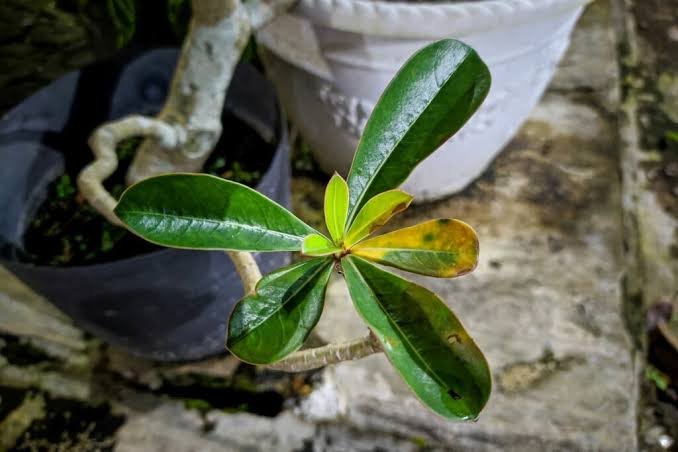
Diseases
The only well-known disease in Desert Rose plants is Powdery mildew. It can be identified by a white powdery appearance on the upper leaf surface and leads to a distorted growth of the plant. It spreads from plant to plant and other plants during cool and damp nights, hence increase in temperature and increasing the sunlight hours can prevent the disease.
Powdery Mildew can be eradicated with the application of sulphur-based fungicides like Bonide Sulfur Plant Fungicide) or copper fungicides (BONIDE Copper Fungicide Dust)
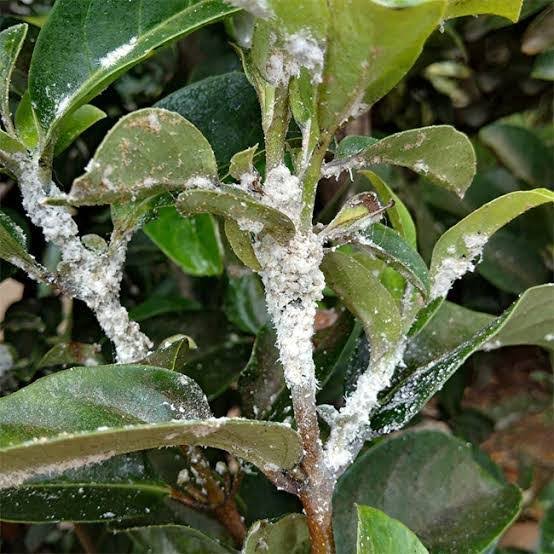
Insects
However, there is no economic loss caused by any insect species in the Desert Rose Plant. The spider mite is sometimes considered a pest. They feed on sap from the underside of the leaves. The plant infected by mites shows discolouration in leaves, webbing and eggs on the underside of the leaves, etc.
Apply neem oil or insecticidal soap or miticides like Azobenzene, dicofol, ovex, and tetradifon to prevent further infection. Once mites are there, they not only cause damage to the plant but also irritate humans and pets. Mite eradication becomes necessary in such cases.

Conclusion
Every year humans adopt many species of plants to cultivate for their benefit. Desert Rose Plant was used by native Africans for its latex, they used to put this poison on their arrow to ease their hunting and safeguard themselves from the enemy. Later on, people realised the use of its latex in medical sciences to treat cancer-like diseases. Yet, the plant is popularised for its ornamental beauty.If you are interested in growing this astonishing plant to add to your gardening collection, first know how to Care for a Desert Rose Plant.
Also Read:

